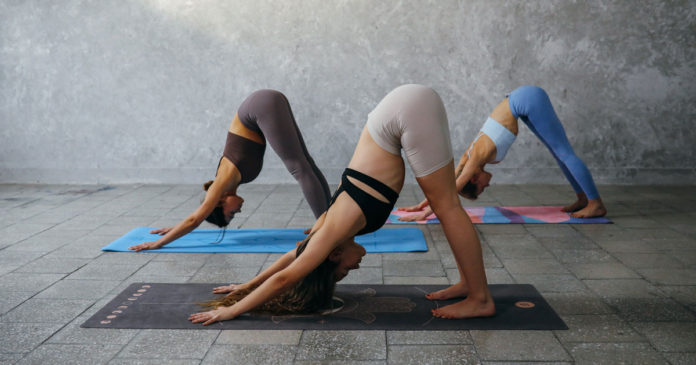In recent years, yoga, an activity that integrates mindful breathing, physical postures, and breathing exercises, has experienced a surge in popularity attributable to its manifold health advantages. Holding positions or asanas for lengthy periods of time is an important part of yoga. This intentional effort of sustaining a precise posture helps practitioners to go further into the practice and get the full benefits of yoga. There is always a question as to how long to hold yoga poses.
Yoga positions need concentration, strength, and flexibility. It tests both the physical being and the intellect, fostering internal balance and harmony. Individuals may build awareness and create a more profound relationship with their body by holding these positions for a prolonged period of time. That’s how long to hold yoga poses.
How long to hold yoga poses go beyond physical health. It aids in the improvement of posture, muscular tone and strength, flexibility, and body alignment. It may also help to relieve tension and anxiety by promoting mindful breathing and relaxation.
Additionally, how long to hold yoga poses allows for a more in-depth investigation of the mind-body relationship. Practitioners learn to be fully present to the moment and create inner serenity by focusing on their respiration while sustaining certain postures.
In this part, we will go further into the value of how long to hold yoga poses . We will go over the many kinds of asanas which are often used in yoga practice, as well as their distinct advantages. This article seeks to give essential insights regarding the value of how long to hold yoga poses for general well-being, whether you are a beginner to yoga or an established practitioner wishing to improve your knowledge.
The Science Behind Holding Yoga Poses: Exploring the Mind-Body Connection
Yoga is more than simply a physical exercise; it also requires an intimate relationship between one’s thoughts and the body. Yoga positions, or asanas, are essential for exploring this body-mind connection and enjoying the advantages of doing yoga.
When you maintain a yoga stance, many physiological and mental processes occur. For starters, how long to hold yoga poses demands focus and concentration, that helps to calm the mind and promote mindfulness. This helps you to totally immerse yourself in the present moment and strengthens your mind-body connection.
Furthermore, how long to hold yoga poses requires the muscles to begin working and engage for a long amount of time. This continuous muscular stimulation not only increases strength but also increases flexibility over time. Your muscles progressively release tension and extend as you maintain a position, resulting in enhanced flexibility in particular regions.
In addition, how long to hold yoga poses might have an effect on your neurological system. When you do certain poses, they turn on your parasympathetic nervous system. This makes you feel calm and relaxed. This may aid in the relaxation of the mind and the discharge of any mental or physical strain contained inside the body.
Concentration, muscular activation, flexibility development, and nervous system modulation are all interwoven activities in yoga postures. knowledge of the mind-body connection throughout your practice will allow you to get a deeper knowledge of yoga while enjoying its myriad physical and mental advantages.
Factors to Consider when Determining the Duration for Holding Yoga Poses
When practicing yoga, numerous things must be considered when deciding the time of holding yoga positions. These considerations include your degree of yoga expertise, physical condition, position needs, and breath control.
The length of time you ought to maintain a position depends on your degree of yoga practice. As their strength and flexibility increase, novices may require shorter durations to maintain postures, whereas more seasoned practitioners are capable of maintaining poses for extended periods of time.
Another key factor to consider is your physical state. It is important to pay attention to how you feel and adapt postures if you are suffering from ailments or limits. Holding postures for an extended period of time might possibly strain or aggravate pre-existing ailments.
Duration is also affected by certain posture requirements. For certain postures, the advantages are best felt after longer holds, while for others, the benefits are best felt after shorter stays or more repetitions of a more dynamic stance.
Breathing regulation is essential in yoga practice. It enables for deeper stretches and helps to quiet the mind. Aim for synchronization between the duration of a pose and your breath: while preparing for the pose, inhale thoroughly, retain it during the exhalation, and then release it during the subsequent exhale.
Determining how long to hold yoga poses is, in essence, a solitary endeavor that demands introspection and attentiveness to the physiological demands of one’s body. It’s important to speak with a certified yoga teacher who can advise you considering your specific circumstances and objectives.
How Long To Hold Yoga Poses
A frequently inquired matter regarding how long to hold yoga poses pertains to the practice of yoga. Although the precise time frame may differ based on the flexibility and expertise of the individual involved, there are some overarching principles to bear in mind.
Prioritize self-care over exceeding one’s physical capabilities and paying attention to one’s body. It is advisable to begin yoga sessions for lesser durations and progressively extend them as one gains comfort, particularly for those who are new to the practice or have physical limitations.
Holding a yoga stance for 15-30 seconds might be an excellent beginning point for novices. This enables the body to develop strength and flexibility while progressively adapting. As your practice progresses, you may strive for longer periods of 30-60 seconds, or even up to one minute for more difficult positions.
However, depending on the intensity or intricacy of the position, certain poses may need shorter time. It is best to follow precise directions from a trained yoga teacher or consult to trustworthy publications that give pose-specific guidance in such circumstances.
Remember that the major purpose of how long to hold yoga poses is to concentrate on perfect alignment, breath regulation, and attentive awareness. Although having a general rule can be helpful, the most important thing is to listen to your body and make changes as needed for a safe and fun exercise.
Mountain Pose: 30 seconds to 1 minute
When it comes to yoga, the time of each posture might vary based on aspects such as your degree of expertise, flexibility, and general comfort. Mountain Pose is a well-known yoga posture recognized for its centering and grounding properties.
The suggested time to hold the Mountain Pose is usually between 30 seconds and 1 minute. This enables you to completely enjoy the advantages of the position while also strengthening and stabilizing your body.
However, it is crucial to modify the duration according to your body’s intuition and what feels comfortable. Beginners may want to begin with shorter periods and progressively expand as they get more comfortable with the position.
Yoga is an individual endeavor; therefore, a universal method does not apply. It’s always a good idea to contact a competent yoga teacher who can help you determine the right length for each position depending on your specific requirements and skills.
Downward-Facing Dog: 1 to 3 minutes
When practicing yoga, it’s critical to know how long to hold each posture for. The recommended length for Downward-Facing Dog, a popular yoga posture, is normally 1 to 3 minutes.
How long to hold yoga poses might vary based on variables such as your degree of practice, flexibility, and general ease in the pose. Holding a position for too little time may not enable you to completely enjoy its advantages, while maintaining it for a prolonged period may cause strain or exhaustion.
1 to 3 minutes is typically regarded as an adequate time range for Downward-Facing Dog. This helps you to stretch and activate muscles while also increasing your strength and endurance. During this period, it’s critical to listen to what your body is saying and make any necessary changes.
Yoga is an individual endeavor; therefore, what constitutes success for one individual might not resonate with another. If you are a beginner to yoga and have any worries about maintaining posture for an extended amount of time, it is always better to visit with a competent teacher who can give specialized assistance to your specific requirements.
Warrior II: 30 seconds to 1 minute on each side
It is critical to understand the length parameters for each position while practicing yoga. Warrior II, a famous yoga stance, often demands maintaining the pose for thirty seconds to a minute of each side.
How long to hold yoga poses might vary based on your degree of skill, adaptability, and ease in the pose. Holding a position for too brief a period of time may not enable you to completely appreciate its advantages, while maintaining it for an excessive amount of time may cause strain or exhaustion.
With regard to Warrior II, this stance aids in the elongation and fortification of numerous body muscles, such as those found in the shoulders, hips, and thighs. Sustaining it for thirty seconds to 1 minute assists you to develop postural stability while also improving strength and endurance.
It is critical to remember to listen to your body throughout your yoga practice. If you experience any discomfort or suffering while holding a position, it is best to release it sooner than the advised time. You may progressively increase the length of holding the positions as you advance in your exercises and grow more comfortable with them.
Overall, basic suggestions such as maintaining Warrior II between 30 seconds up to one minute on both sides strike a balance between pushing yourself and maintaining your safety throughout your yoga practice.
Triangle Pose: 30 seconds to 1 minute on each side
When practicing yoga, a recurring question is how long each posture should be maintained for maximum benefit. In the instance of the Triangle position, it is usually best to hold the position for thirty seconds and a minute on each side.
How long to hold yoga poses might vary based on variables such as your skill level, flexibility, and general comfort in the pose. Holding a position for too little time may prevent your body from completely engaging and benefiting from the flex, while maintaining it for a prolonged period may cause strain or exhaustion.
When you hold Triangle Pose for 30 seconds to one minute on each side, your body has enough time to find support and sink deeper into the pose. This pose is known for stretching and strengthening many muscles in the body, including the legs, pelvis, and core.
Bear in mind that yoga is an individual endeavor, and that paying attention to your body is vital. If you are unfamiliar with this position or have any special concerns or restrictions, it is always recommended that you check with a skilled yoga teacher who can lead you through correct alignment and duration depending on your unique requirements.
Tree Pose: Start with 30 seconds and gradually increase up to 2 minutes
When practicing yoga, it’s critical to know how long to hold each posture for. While doing the Tree Pose, it’s best to start with 30 seconds and slowly build up to 2 minutes.
Tree Pose, Sanskrit equivalent: Vrksasana, is a balancing position requiring concentration and stability. Holding this stance for a sufficient period of time helps you to completely benefit from its advantages.
Commencing with a reduced duration, such as 30 seconds, facilitates the development of muscular strength and stability as the individual acclimates to the pose. You may progressively extend the time you spend in the Tree Pose as you feel more comfortable and confident.
Extending the length to 2 minutes allows for greater connection with the position. It facilitates additional muscle strengthening and stretching, which enhances balance and concentration.
It is crucial, nevertheless, to pay attention to your body’s signals and refrain from exceeding its capabilities. If you experience any pain or strain throughout the posture, it is best to exit it sooner or later as required. Remember to practice yoga thoughtfully and with regard for your own skills.
A trained yoga teacher may also give individualized advice on how long to hold various postures depending on your level of expertise and physical condition.
Cobra Pose: Hold for up to 30 seconds
Understanding how long to hold yoga poses is critical while practicing yoga poses. It is normally suggested that you hold the Cobra Hold for at least 30 seconds.
Yoga posture time standards vary based on things such as your degree of practice, flexibility, and general physical condition. Holding a position for too little time may not enable you to completely enjoy its advantages, while maintaining it for a prolonged period may cause strain or exhaustion.
Holding Cobra Pose for 30 seconds enables your entire body to loosen up and tone the muscles in your back, open up the muscles in your shoulders and chest, and enhance spinal flexibility. This time allows you to concentrate on good alignment and breathing methods.
Understand that every person’s physique is unique, so pay attention to your particular body’s cues throughout practice. If you are fresh to yoga or may have special concerns or limits, you should always speak with a competent teacher who can assist you on appropriate form and length for each position.
Pigeon Pose: Hold for up to 5 minutes on each side (advanced practitioners)
Whenever it involves yoga positions, how long to hold yoga poses might vary based on your degree of expertise, flexibility, and general comfort. The Pigeon Pose is advised for experienced practitioners to hold for a maximum of five minutes on both sides.
How long to hold yoga poses helps your body to get the most out of the stretch and eliminate any tension or stiffness in the muscles being targeted. Yet it is essential to pay attention to what your body is telling you and not force yourself too far. If you are a novice or have any limitations, you should begin with shorter periods and progressively expand as you gain comfort.
Keep in mind that yoga is a personalized practice; what’s effective for a single individual might not be successful for another. It is always advisable to seek the advice of a competent yoga teacher who can advise you depending on your specific requirements and skills.
Tips for Improving Your Ability to Hold Yoga Poses Longer
How long to hold yoga poses requires a mix of strength, flexibility, and breath control skills. Here are some pointers to help you improve the way you do yoga and hold poses for longer periods of time.
- Pay attention to good alignment: Maintain proper alignment in each position. This helps to equally divide the burden throughout your muscles, reducing tension and fatigue.
- progressively increase duration: Begin by holding each posture for a comfortable length of time and progressively increase the duration as your strength and flexibility improve. Push yourself softly, but don’t overdo it.
- Build core strength: A strong core gives stability and support throughout postures. In order to improve your abdominal muscles, include workouts such as planks, boat posture, or Pilates in your program.
- increase your flexibility: Stretching activities apart from yoga practice may help you increase your general flexibility, which makes it easier to maintain postures for longer periods of time. Stretches that target particular muscle groups utilized in yoga postures should be included.
- Use accessories: Equipment such as blocks, belts, or bolsters may help with good alignment and make postures more accessible for extended periods of time.
- Employ controlling your breathing methods: Expanding your breath and syncing it with movement will help you quiet your mind and relax your body during difficult positions. Maintain a constant beat by taking slow inhales and exhales.
- Be sympathetic with yourself: Improvement takes a period of time so be kind with yourselves as you attempt to hold positions for longer periods of time. To keep motivated, celebrate tiny victories along the road.
Remember
Remember that everyone’s path is different, so pay attention to your body’s signals and alter or rest as required to prevent harm. By constantly applying these strategies into your yoga practice, you may progressively increase your ability to maintain postures for extended periods of time while increasing strength, flexibility, and learning breath control skills.
Conclusion: Find Your Balance in Holding Yoga Poses and Reap the Benefits
Finally, achieving the appropriate balance in yoga postures is critical for receiving the advantages of your practice. You may improve your entire experience and obtain ideal outcomes by implementing some yoga practice ideas, such as concentrating on improving strength and flexibility and practicing breath control methods.
When holding yoga positions, it’s critical to create a balance among effort and ease. Overexertion may result in strain or damage, while not pushing oneself enough might stymie growth. Locating that sweet spot when you feel a mild stretch or muscle activation is essential.
Yoga helps you build both strength and flexibility. Posing helps you develop these traits by engaging various muscular groups and gradually strengthening their endurance. This increases not just the way you perform physically but also your body knowledge and alignment.
Breathing methods are essential for keeping balance during yoga positions. Deep breathing may assist to quiet the mind, improve attention, and induce relaxation. It also enables you to interact with yourself on a more profound level, allowing you to hold positions more comfortably and steadily.
Remember that everyone’s yoga experience is different, so be patient with oneself as you experiment with various positions to discover which one works most effectively with your body. You may unleash the various mental, physical, and emotional advantages that this ancient practice has to offer by striking the right equilibrium in holding yoga positions via attentive practice.









